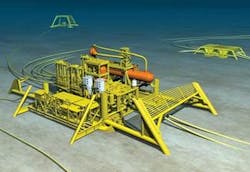Tordis becomes world’s first subsea processing installation
Gene Kliewer, Technology Editor
StatoilHydro’s Tordis field improved oil recovery subsea separation, boosting, and injection (SSBI) project makes the Top 5 list as the world’s first commercial subsea processing system. In the Norwegian North Sea in 200 m (656 ft) of water, Tordis consists of four fields all developed subsea and producing through a tieback to the Gullfaks C platform.
The first of the fields came onstream in 1994 and the last in 2001. When water production increased to 70-80% and sand to 500 kg/day (1,102 lb/day), then Statoil began to plan the SSBI system. The new technology is expected to increase recovery from 49% to 55%, or about 35 MMbbl of additional oil.
The actual system consists of a water/sand separator that will take those out of the production stream and re-inject them into a subsurface formation for storage. The multiphase pump will drive the oil and gas through the existing pipeline to Gullfaks C.
FMC Technologies Inc. was contracted by Statoil to develop the processing system. FMC called on Framo Engineering for contributions to the subsea pump and boosting, and CDS Engineering for its gas-bypass design to keep the seabed separator as compact as possible.
“Tordis is a perfect application of subsea separation,” says Erlend Fjøsna, Subsea Processing Systems manager of FMC Technologies. “The field is maturing, so its wells are producing more and more water. That is restricting production because the flowlines and the surface facilities do not have the capacity to transport and handle all of the extra water.”
The design highlights of the Tordis separator are its internal level detectors for sand, emulsion, water, and oil, plus the gas bypass line, according to FMC. The sand system includes a gravity-fed cyclonic separator. The sand is injected downstream from the water injection pump. That pump was fitted with tungsten carbide impellers to increase wear resistance.
“By flushing the sand into the desander module, and then from there into the disposal well, mixed with separated water, we save the injection pump considerable wear and tear caused by the abrasive effect of sand passing through it,” says Ann Christin Gjerdseth, project manager of FMC Technologies, Kongsberg.
The conceptual differences between subsea and topside processing were critical to success. The typical heavily instrumented topsides now needed to have simple, easily replaced components that worked under water.
Assembly took place in March at Tønsberg in southern Norway where the 500-ton (453-metric ton) foundation base structure and some of the modules were built. Because of the restricted craneage available, the base structure was rolled onto a barge and the two heaviest modules - the 230-metric-ton (253-ton) manifold and 170-metric-ton (187-ton) separator vessel - were lifted onto it by a floating crane vessel. The partly assembled station then was rolled back into the construction hall for installation of the desander, multiphase and water flow modules, and the two 2.3 MW pumps.
Saipem’s crane-bargeS7000 did the installation. With dimensions of 40 x 25 x 19 m (131 x 82 x 62 ft), and weighing 1,250 tons (1,134 metric tons), it is believed the unit was the heaviest subsea lift ever performed by the barge.
The pipeline inline manifold (PLIM) connects the flowlines from the Tordis subsea manifold to Gullfaks C to allow re-routing the Tordis production stream via the subsea separation system. It also allows bypass of the separation system.


